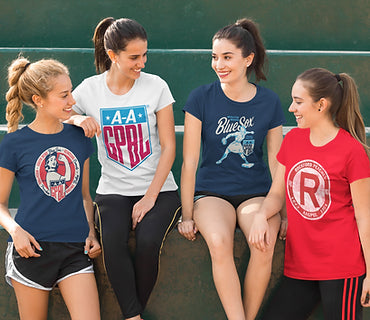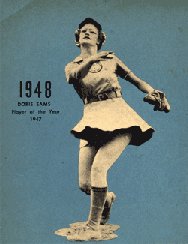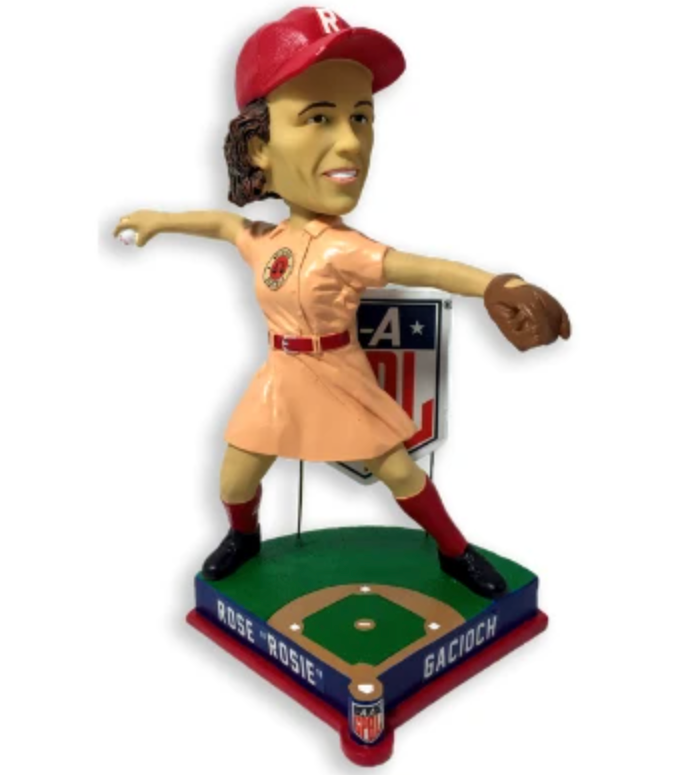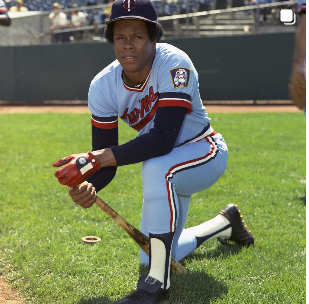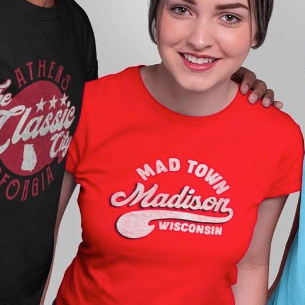This week as part of Women's History Month, we introduce you to Doris Sams, who was an AAGPBL legend.

From AAGPBL Website:
Sammye was Player of the Year in 1947 and 1949, won the batting championship in 1949, and was home run champion in 1952 with 12 homers. She was the type of player that was always calm, cool and collected, even when the going got tough. Not only did Sammye do a good job on the mound but she was a force at the plate with the bat. She pitched a perfect game against Ft. Wayne in front of 6,000 fans.
Sams, Doris "Sammye" By Jim Sargent
For eight years after World War II, Doris Jane “Sammye” Sams, an excellent fast-pitch softball player from Knoxville, Tennessee, enjoyed an outstanding career in the pro All-American Girls Baseball League (now known as the All-American Girls Professional Baseball League). By the time her final season ended in 1953, Sammye, as friends called the right-handed batter, had fashioned a career average of .290, the league’s sixth highest lifetime mark. She also set a new league home run mark, hitting 12 four-baggers in 1952. Following the 1947 season, Sammye’s second year, she was selected as the league’s Player of the Year. A pitcher turned outfielder, she was named to the All-Star team at both positions. No other player in the twelve-year history of the AAGPBL accomplished that feat. Sams was a gifted all-around athlete. Not only did the tall right-hander pitch a perfect game for the Muskegon Lassies on August 18, 1947, defeating the Fort Wayne Daisies, 2-0, but she batted .280, the third highest average among the league’s regulars, plus she contributed 41 RBIs. After three seasons of using underhand hurling, the All-American (as players often called the league) shifted to a modified underhand delivery in 1946. In 1947, the league switched to a sidearm pitching delivery, and on August 18, Doris, a natural sidearmer, hurled a perfect game and won, 2-0, finishing the season with an 11-4 record. Further demonstrating her strong arm, the Tennessee native tied Rose Gacioch’s record of 31 outfield assists in a season.
Sams was such an outstanding performer that she won the Player of the Year award again in 1949. The only other player in the All-American League who twice won that honor was Jean Faut, the greatest overhand pitcher in league history. Jean was selected Player of the Year in 1951 and 1953.
A five-time All-Star during her eight-year pro career, Sams made the circuit’s honor team in 1947 and from 1949 through 1952. One of the league’s best hitters, she averaged more than .300 during each of her last four seasons. A fine defender and a gazelle in the outfield, Sammye often took away extra-base hits from opponents with a variety of excellent catches over the years.
The only daughter of R.J. and Pauline Sams, Doris was born in Knoxville on February 2, 1927. She grew up with two sports-minded older brothers. “I feel like I’ve played ball since day one out here on the fields with my brothers, Paul and Bob, Jr,” Doris reminisced in a 1997 interview in Knoxville.
“I loved to play football, too. I played football with the whole group out here in the fields, but when I got to be about twelve years old, I quit that,” she added, with a chuckle.
Friendly, witty, and outgoing, the 5’9” Sammye, who wore glasses, excelled in almost every sport as a youth. Reflecting on her early influences, she explained her grandfather was a semiprofessional hurler who helped her learn to pitch. Also, her father, an outfielder, played semipro ball until he got married. Thus, she soon acquired the baseball dream.
An attractive brunette, Sams remembered her softball playing days started in 1938 when a fellow who organized the girls’ teams told her to go and sign up with the city’s recreation department: “Sure enough, one of those fast-pitch teams picked me up when I was eleven years old, and I started pitching for them. Most of the girls were a good five, six, or seven years older than I was. We ended up winning six or seven state championships.
“I started out with Nelson’s Cafe. The Pepsi Cola Company bought it. They took over the team after we won two or three championships. I played for Pepsi Cola until 1946, and that’s when I got into pro ball.”
Doris attended Knoxville High, graduating in January 1945. However, she didn’t play school sports because she was involved in city softball. In fact, before she became known as a softball star, Doris had already achieved local notoriety. In 1938 she won the regional Southern Appalachian Marbles Tournament, becoming the first girl to qualify for the National Marbles Championship in Chicago. She didn’t win in Chicago, but later the versatile young woman began playing badminton. In 1942 she won the Knoxville Badminton Championship. She also won the women’s badminton doubles title with Emily Hartman, and she captured the mixed title with Willard Martin, two friends who were also accomplished athletes.
“I love badminton,” Sammy reminisced. “If you get somebody who can play badminton, you’ve got somebody who can move. That’s the fastest game I’ve ever played.”
Further, Sams was adept as a swimmer and a diver. No matter the sport, she excelled, but her greatest sport turned out to be baseball. In 1946, after World War II ended, Doris needed a job. One day she stopped by Manzer’s Studio to have her picture taken. When she entered, she saw a woman working in the back, trying to get a baby to stop crying long enough to take pictures. Seeing the photographer’s dilemma, Doris started crying like a baby, causing the infant to hush. After taking the pictures, the manager asked if she wanted a job, and Sams ended up working there. Later, when she returned from playing ball in Michigan, she worked several off seasons for Manzer’s, and the lady operating the business nicknamed her Sammye.
“The way I got involved with the All-American League,” Sams recounted in 1997, “is that a kid who was fourteen, and who used to go fishing with my Dad, came over here in the spring of 1946. He said, ‘Doris, I heard on the radio that there’s going to be two professional girls baseball teams pass through here.’”

Her friend explained the teams were playing exhibition games on their way to the Midwest from spring training in Mississippi. Though she was reluctant, another friend finally convinced Sammye to go to the team’s hotel and talk to the manager.
Doris recalled, “I went over there and knocked on that door, you know, and took a big, deep breath. This guy came to the door, and I introduced myself and said, ‘I play softball around here, and I want a tryout.’
“He said, ‘Well, are you any good?’
“Now he swears that I said this, but I don’t remember it. I looked him right in the eye and said, ‘Well, I hit a home run about every time I get up!’” Sammye laughed, adding, “That was the Racine manager, Leo Murphy. It was raining cats and dogs that day. I knew there wasn’t any way I could try out for them here.”
Murphy took Sams on the team bus to Chattanooga, where she tried out and made the club. The manager instructed her to go home, pack her bags, and meet them in Michigan. Doris had not been away from home in her life. “I still can’t figure out how I went right through it,” she recalled, “Of course, I was homesick, like the other girls, the whole first year. But I thoroughly enjoyed every blame day of playing ball.”
A few days later, Sams traveled to Michigan by airplane, a “first” for her. Allocated to Muskegon, an expansion team, Sammye played her entire All-American career with the Lassies. Financially strapped by mid-1950, the franchise was sold to Kalamazoo. A modest, likeable, multi-talented ballplayer, she became as popular in Kazoo as she was in Muskegon.
In Muskegon, Sams lived with a local family. Two other Lassies lived in the home where Doris lodged. Each year she and two teammates had one room and kitchen privileges in the same private home. She remembered paying $5 a week for the room. Also, she started her pro career by earning $65 or $70 a week, double the salary she earned with Manzer’s Studio.
Sams played for several managers, beginning in 1946 with Ralph “Buzz” Boyle, a former Brooklyn Dodger outfielder who hit .290 lifetime in five big league seasons, ending in 1935. Bill Wamby (born Wambsganss), an infielder with Cleveland for thirteen years, managed the Lassies in 1947 and 1948. Later Lassies’ pilots included Carson Bigbee, Mitch Skupien, and, for a time in 1952, Mary “Bonnie” Baker, who served as player/manager for part of the season.
Reflecting on the 1946 season, Sammye explained her delivery: “I had three different ways of pitching underhand. I pitched a figure-eight, and then the submarine because I was a natural sidearmer, and then I had the windmill. Today the biggest part of the fast-pitch softball players are pitching the windmill.
“We were playing Grand Rapids one day. When I first hit that league, all I heard was ‘Connie Wisniewski, Connie Wisniewski.’ So I thought, ‘If you can beat that team, You’ve got it made.’
“We were leading Grand Rapids and Wisniewski by one run. I walked somebody, and the runner stole second. Anyway, the runner ended up on third with two outs. We were about to get beat. That was the last inning.
“I said, ‘Well, nobody’s ever seen me pitch this windmill. I’m going to try it on this gal.’
“I had two strikes on Doris Tetzlaff, and I went around about six times, and I released it, and the ball just happened to hit the heart of the plate. She’s still standing there!”
Sams recalled throwing mostly the figure-eight, which gave the ball a crazy spin and often caused the batter to hit a pop fly.
“But I was a natural sidearmer. When they put me in the outfield, my catcher just called me everything. When I threw from the outfield, I was throwing the awfulest curve you ever saw. When the league went to overhand pitching [in 1948], it like to killed my arm. They kept screaming, ‘Overhand! Throw Overhand!’
“I tried pitching overhand, but it liked to ruin my arm. I got tired of pitching anyway. I wanted to play all the time. I started out playing right field. But I was pretty good at shagging flies, so I ended up in center field before it was all over.”
Playing in 42 games in 1946, the rangy, rugged Sams, who swung a 35-inch bat, hit .274, going 29-for-106, with a double and nine runs driven home. Her average was seventh best in the league for players with 100 or more at-bats, an auspicious start for the nineteen-year-old rookie. Pitching in 25 games, she compiled an 8-9 record with a 3.78 ERA.
But from 1947 through her final season of 1953, Sams was outstanding. Playing the outfield in her second season, the Knoxville native produced the league’s fourth highest average (third highest among regulars), hitting .280 with nine doubles, five triples, and 41 RBIs.
As a hurler in 1947, Sams ranked second in the league behind “Millie” Earp of the Grand Rapids Chicks. Earp posted a 20-8 record with a 0.68 ERA in 35 games. Mainly a right fielder, Sammye pitched 19 contests. She fashioned a record of 11-4, a league-high winning percentage of .733 with an 0.98 ERA. In 136 innings, she allowed 26 runs, struck out 34, and walked 28.
In April 1947, all of the league’s players were flown to Havana, Cuba, for spring training. The trip was a highlight experience for many of the girls, and Sammye remembered it well: “It was hotter than Hades for one thing! It must have been 110 over there. But it was interesting. I’d never been anywhere, really. Havana was real good. Golly, the people were bug-eyed. They just couldn’t believe that women were playing ball like that! We drew thousands of fans.”
After the Cuban adventure, the teams paired off and played exhibition games, traveling by train to their home cities. That exhibition schedule helped get the players ready for the opening of regular season games in the last week of May. But the highlight of Sams’ sophomore season came on August 18, 1947, when she won for the eleventh time by pitching a perfect no-hit game, defeating the Fort Wayne Daisies, 2-0. Muskegon went on to win the All-American’s regular season title with a 69-43 record.
Recalling her perfect game in 1997, the modest Sams observed, “It wasn’t so perfect. They hit me like a drum. But it was one of those days when everybody was on their toes. They were catching line drives. You know, the pitcher doesn’t do it alone, let’s face it. They caught line drives and everything else—just unreasonable catches that day.”
For example, Fort Wayne’s Dottie Schroeder smashed a shot down the third base line in the fourth inning. The ball took a bad hop, but agile third sacker Arleene Johnson, who had seven assists and three putouts for the evening, jumped up, speared the ball with her bare hand, and threw Schroeder out at first.
Also, Sally Meier lined one to left field in the fifth, and Lassie flychaser Jo Lenard came up with a fine shoe-string catch. When Velma Abbott bunted in the sixth, Sams made a great fielding play and threw Abbott out at first—by a slim margin.
“The last ball they hit was by a pinch-hitter, Mary Rountree,” Sammye explained. “I threw one in there, and she hit that thing back to me like a bullet. It took one hop, and I couldn’t get it. It hit me on the knee, and ricocheted up in the air, and Tex Fischer came running in from shortstop and caught that thing, and threw it to first—and ended the game. I mean we had everyone out there run to death!”
Sammye recalled the game as less than perfect, but 5,728 paying spectators were thrilled by the home team’s performance. According to the Muskegon Chronicle, the game was actually watched by at least 7,000 fans. When the club permitted people with unused tickets to attend this contest, an additional 1,500 sat in improvised bleachers.
That night the Lassies were facing the Daisies’ star right-hander, Dottie (Wiltse) Collins, who compiled a 20-14 record in 1947, and Sams’ bat helped produce her team’s first run. She singled to open the fifth inning, moved to second base on a sacrifice, advanced to third on an infield out, and scored when Tex Fischer grounded a single to center field. Muskegon scored again in the eighth when Charlene “Shorty” Pryer beat out a bunt, took second on a passed ball, stole third, and scored when Sara Reeser bounced a double down the third base line. When the final out was recorded, the large crowd surged onto the diamond, congratulating their heroines, notably Sams.
Chronicle sportswriter James F. Henderson wrote, “Calm and cool at all times, Sammy is the tempering force of the team. Where another might become ruffled, she maintains a placid demeanor.
“One of the leading all-around players in the league, Doris has more than an even chance of making the league’s all-star team this season.” Although there would be plenty of indignant fans if Sams was not picked for the All-Star team, Henderson observed, “It won’t bother Doris much either way, just so long as she gets one more trip to the plate—and one more crack at the ball.”
Thanks partly to Sams’ stellar play, Muskegon rose from sixth place (of eight teams) and a 46-66 record in 1946 to first place with a 69-43 ledger in 1947. A timely hitter with a good eye and a quick bat, Sammye banged out twelve hits in the five contests preceding her perfect game, boosting her average above the .300 mark and moving her into second place behind Audrey Wagner, the league leader at the time. When the season ended, Rockford first sacker “Dot” Kamenshek had won her second consecutive batting title, averaging .306.
In the league’s Shaughnessy Playoffs, however, the Racine Belles, regular season and playoff champions in 1946, ousted the Lassies. The Belles tied for second in 1947 with Grand Rapids, as both teams fashioned records of 65-47. However, Racine was loaded with pressure-tested players such as infielders Sophie Kurys and “Maddy” English, outfielders “Edie” Perlick and Eleanor Dapkus (who also pitched), and right-handed ace Anna May Hutchison. Playing in Muskegon, the Belles won the first two games of the best-of-five playoff. Moving to Racine, Muskegon rookie Nancy “Hank” Warren (she went 17-11 in 1947) won game three. But the Belles won the crucial fourth game, 2-1, by squeeze-bunting in a run in the ninth inning. A few days later, Grand Rapids defeated Racine in a best-of-seven playoff for the All-American Championship.
Sams observed, “That was the year we were in the playoffs and we were gonna play Racine, and they beat us. We were so sure of that playoff because we had just beat Racine down the road all year. We just fell apart. Youngsters in the playoffs, I guess.”
In 1948 the All-American League expanded to a historical peak of ten teams divided into Eastern and Western Divisions, but the biggest change came with the shift to overhand pitching. Sams returned and enjoyed another first-rate season in the outfield, but she never really made the adjustment to baseball-style pitching. In 117 games, Sammye hit .257, ninth in the AAGPBL, slugging six doubles, seven triples, and three home runs, and producing 59 RBIs.
The Knoxville star performed well all season long, opening the campaign by hurling a no-hit, no-run game for a 3-0 victory over the Springfield, Illinois, Sallies, one of the league’s two new clubs—along with the Chicago Colleens. In the second game against Springfield, Muskegon won again, this time fueled by the big bat of the hard-hitting Sams. The pitcher-turned-outfielder tripled in the first inning to drive in “Dottie” Stolze, who walked and stole two bases, and Tex Fischer singled home Sams for a Lassie 2-0 lead. In the fifth, Sammye singled and, after an out, rode home on a base hit by Amy “Lefty” Applegren. After the Sallies tied the game with a three-run rally in the top of the sixth, Jo Lenard singled, and Sams belted a long drive over the left fielder’s head, a ball that rolled all the way to the 345-foot marker for a home run. Still, the game-winning run came in the bottom of the eighth when Lenard tripled and scored on a balk. Springfield tallied twice in the top of the ninth before Hank Warren retired the side to win, 6-5.

In the Eastern Division, however, Grand Rapids struggled to defeat the third-place South Bend Blue Sox (57-69) in the best-of-five playoff, finally winning the fifth game, 3-0. Second-place Muskegon faced fourth-place Fort Wayne (53-72), and the Lassies won the opening game, lifted by the hurling of Lefty Applegren (she went 15-12 in 1948). Still, Fort Wayne won the next three contests behind the slants of Annabelle Lee (she beat Sams in game two, 5-3), Donna Cook, and Kay Blumetta, again eliminating the Lassies from the playoffs. As it happened, Rockford, the league’s playoff champion in 1945, won another title by defeating Fort Wayne in five games.
The Tennesseean could easily have made the All-Star team in 1948, but she was overlooked. Batting a lofty .309 (the league’s only .300-plus hitter) with four home runs and 56 RBIs, Kenosha Comet outfielder Audrey Wagner, who was also named Player of the Year in 1948, made the All-Stars. The other two All-Star flychasers had statistics similar to Sams: Racine’s Edie Perlick averaged .243 with two home runs and 51 RBIs, and Grand Rapids’ Connie Wisniewski hit .289 with seven homers and 66 RBIs.
Still, Sams loved playing baseball, and she enjoyed an unusual highlight. On April 11, 1948, her hometown paper, the Knoxville News-Sentinel, reported “Knoxville’s gift to the All-American Girls Professional Baseball League” shared the cover (Sammye was on the back) of Dell Publishing’s Major League Baseball: Fact and Figures with Ted Williams, Boston Red Sox slugger and the American League’s Player of the Year in 1947. The story pointed out Sams was voted the All-American’s Player of the Year in 1947 as both pitcher and outfielder. Also, her parents planned a trip to Muskegon to see her play ball. The previous year they made the long trip by automobile to see Doris play a series in Kenosha, Wisconsin.
The News-Sentinel article quoted Bob Sams as saying, “I tried to keep her from playing at first because she came in with cuts and bruises, but now we are all behind her and very proud of her.”
As Sams continued to star, the All-American League continued to evolve. From the inaugural season of 1943 to mid-season of 1949, the league used a plastic-centered “deadball” which steadily dropped from 12 inches in circumference in 1943 to 10 inches. Beginning around July 20, 1949, the league issued new 10-inch balls with a cork center and red laces. Also, the pitching distance was increased from 50 to 55 feet. In addition to giving players a ball easier to see and livelier to hit, the game more nearly approximated baseball distances. As a result, batting averages rose all around the circuit. Further, the red laces contributed to convincing fans that the All-American league was playing “real” baseball. Sams produced another very good season in 1949, topping all regulars with a .279 average. Sammye was chosen Player of the Year for the second time in 1949. She also made the All-Star squad for the second time, and she continued to be chosen as an All-Star outfielder through 1952.
However, the Lassies never won another pennant during Sams’ career. In 1949 Muskegon fell to sixth place (of eight teams) with a record of 46-66. By mid-season of 1950, poor attendance caused the franchise to be sold to Kalamazoo. The change of scenery didn’t help. The Lassies finished last of eight teams with a record of 36-73. In 1951, when the league’s season was divided into a first and second half (as was the custom during the first two wartime seasons), Kalamazoo came in seventh in the first half with a 19-38 record and last in the second half with a 15-37 ledger. In 1952, with the league reduced to six teams, the Lassies ranked fifth with a 49-60 record, missing fourth place by half a game. Competing against the same teams again in 1953, Kalamazoo climbed to third with a 56-50 ledger, the team’s first winning season since 1948.
During those years, Sammye’s career was punctuated with highlights, including that she:
- Pitched a one-hitter, contributed two hits, and drove in one run as Muskegon beat the South Bend Blue Sox, 3-1, on July 14, 1949
- Hurled a three-hitter to stop the Blue Sox, 2-0, on August 19, 1949. She singled and scored Muskegon’s second run in the top of the ninth, then stifled a two-on, one-out rally in the bottom half by inducing the last two Sox hitters to pop out
- Pitched and batted Kalamazoo to a 3-1 win over Racine on July 10, 1950, allowing two singles and belting two triples herself, the second driving home Bonnie Baker with what proved to be the winning run in the top of the eighth
- After singling and scoring on a double by Jenny Romatowski in the eighth, Sammye belted a long home run in the tenth to beat the Peoria Redwings, 5-3, on August 30, 1951
- Appeared on the cover of the August 1952 issue of Greater Kalamazoo: News and Views as the city’s “Queen of Swat,” commemorating her record-tying ten home runs to date and indicating Sams hoped to be the “Home Run Queen!”
In fact, the Kalamazoo clouter enjoyed her greatest single season in 1952, besting the All-American League’s all-time home run record of 10 set in 1943 by Racine’s Eleanor Dapkus. In her next-to-last year, Sams produced a .314 average, a new record of 12 four-baggers, and 57 RBIs. She slugged the record-tying tenth home run in a July 4 double-header sweep over the Rockford Peaches. One month later, on August 4, Sammye set the new record with home run number eleven against the Fort Wayne Daisies.
An AAGPBL veteran in her seventh season, the smoothing-swinging Sams seldom endured a hitless night in 1952. Playing every game and batting cleanup, she gave a glimpse of her power in Battle Creek against the Belles on May 21, hitting a triple, a double, and a single in four at-bats, helping “Dottie” Naum earn her first victory and squaring the Lassies’ season ledger at 2-2. At Kalamazoo’s CAA Field on Saturday, June 7, Sams tried her hand at pitching for the first time since 1950, but the experiment failed, and Kalamazoo fell to league-leading South Bend, 13-4. Still, Sammye hit her first home run of the season deep to left center, making her the first Lassie ever to clear the fence at CAA Field. According to the Kalamazoo Gazette, the blast earned her a “big hand” from a small early-season crowd of 952 fans.
On Sunday, June 22, Sams swung a hot bat, helping her club sweep a double-header from Grand Rapids by scores of 3-0 and 2-1. In the opener, Ruth Williams shut out the Chicks on four hits. In the sixth, with the Lassies ahead 1-0, Grand Rapids’ 6’2” right-hander Earlene “Beans” Risinger gave up a single to June Peppas, and Sams followed with a home run over the fence in left center, boosting the lead to 3-0. In the nightcap, Dottie Naum, playing shortstop, singled and advanced to second on a sacrifice. After Peppas flied out, Sams blasted a long home run over the center field fence for the winning margin of 2-1. Lassies’ right-hander Gloria Cordes yielded a solo run in the sixth, but spaced seven hits to win her fifth game, thanks to Sams’ homer.
Four days later at Fort Wayne, in yet another double-header, Sams homered in the seven-inning opener (the league’s custom for twin bills) for her team’s only run, as the Daisies won, 5-1. In the nine-inning nightcap, Cordes won her sixth game, thanks to her teammates’ timely hitting. With the score knotted at 4-4 in the top of the ninth, Cordes opened with a single, Mary Carey followed with a double, Bonnie Baker scored Cordes with a sacrifice bunt, and June Peppas brought home Carey with a bunt single. Sams capped the four-run rally with what the Kalamazoo Gazette called “the longest homer ever recorded over Fort Wayne’s left field bleachers.” Sammye’s fifth round-tripper gave her the league lead over the Daisies’ Betty Foss, who had four.
Sams continued her hot hitting. On Saturday, June 28, in Rockford, she fueled Kalamazoo’s third straight win with her sixth home run, a two-run, 290-foot drive into the left field corner. Coupled with the three-hit hurling of Jean Marlowe, the Lassies, while still in last (sixth) place, improved to a 12-22 record. In a 7-4 loss in South Bend on June 30, Sams drove in three runs in a 2-for-4 performance, the second hit being a long solo blast—her seventh homer—into the left field seats. Playing a twin bill on Tuesday, July 1, the Lassies fell in the opener, 1-0, as Kay Blumetta tossed a three-hitter but lost when the Blue Sox bunched a single and a double in the seventh inning to give Janet Rumsey the victory. In the nightcap, however, Sams delivered a grand slam homer in the fifth to erase a 3-2 deficit and put the Lassies ahead, 6-3. Cordes pitched the distance, giving up 12 hits but earning her eighth victory, 9-4, as Sams went 3-for-5 and contributed 5 RBIs.
Three days later, on Friday, July 4, Rockford defeated Kalamazoo in the afternoon tilt of a day-night double-header. In the opener, Sams singled in the fourth inning and tallied her team’s only run on a double by Fern Shollenberger. In the nightcap that preceded a 30-minute display of holiday fireworks, Sams enjoyed her only two-homer game. A standing-room only crowd of 3,282, including 600 kids under age twelve who got in free, saw “Dauntless Doris” (a nickname used by the Gazette) deliver a perfect 4-for-4 night to help Jean Marlowe and the Lassies pick up a 16-3 triumph. Three Rockford hurlers gave up a total of 17 walks, the Lassies banged out 12 hits, and Sams, with two home runs and five runs-batted-in, tied the 1943 record of 10 homers in a season set by Eleanor Dapkus. The following evening, Sams failed to connect for the circuit. Regardless, she hit four straight singles and batted in one run, helping her team win, 6-4, and climb ahead of Battle Creek into fifth place with a 17-26 ledger.
Also, three Lassies made the league’s midseason All-Star game: Sams, Cordes, and veteran infielder Fern Shollenberger, who joined the Lassies in 1952 after six seasons with the Kenosha Comets. On Monday night, July 7, in South Bend, the best players from the other five teams faced the Blue Sox, the league’s 1951 playoff champions, and the All-Stars prevailed, 7-6. Shollenberger, who singled in her first at-bat, ignited a sixth inning rally with a walk. Before the outburst ended, the All-Stars scored six runs, capped by Sams’ two-run homer, to take a 6-4 lead. After the Blue Sox scored twice in the eighth to knot the contest, Betty Foss of Fort Wayne singled and stole second in the ninth. Up stepped Sams, and she promptly rapped her third hit, a single to score the go-ahead run. When Cordes retired South Bend in the bottom of the ninth, the All-Stars celebrated a victory. On the trip home to Kalamazoo, Sammye smiled about her eleventh four-bagger, even though the blast didn’t count in the official regular season records.
Thereafter, Sams, who could make a good fast ball disappear from the ballpark, usually saw a diet of curves and breaking pitches, or, in clutch situations, received intentional walks. The “walk her” strategy began the following night, July 8, when the Blue Sox visited Kalamazoo and defeated the Lassies, 1-0. With two outs in the ninth and June Peppas at first base on a fielder’s choice, South Bend’s “Dot” Mueller passed Sams intentionally and saved the game when pinch-hitter Jean Lovell sent a hot liner to the shortstop. On July 12, when Kalamazoo defeated Battle Creek, 3-2, Sams went 1-for-3, with her hit being a long single off the wall in left center. The following night, in a twin bill against the Belles, Sams went 2-for-2 with a walk in the first game. In addition to a double, she tripled off the center field wall, and the long drive came within inches of being home run number eleven. Still, the Lassies, won both games, and Sammye drew two intentional passes. And so July turned into August, and she failed to hit again for the circuit.
On Friday, August 1, at CAA Field, Kay Blumetta pitched a two-hitter, one being a home run by Katie Horstman, to stop Fort Wayne, 3-1. Sams batted in one run and belted a pair of doubles. Many in the crowd of 1,130 rose to their feet when it looked like one of her two-baggers was going over the fence, but it fell short. Finally on Monday, August 4, at home against Fort Wayne, Sams hammered a two-run shot, her eleventh home run.
Author: Jim Sargent Contributed By: Jim Sargent
#HistoryInYourSize



